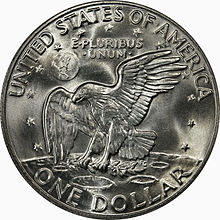Eisenhower Dollar
| United States | |
| Value | 1 U.S. dollar |
|---|---|
| Mass |
Copper/nickel-clad: ~24.624 g (380 gr) |
| Diameter | 38.1 mm (1.5 in) |
| Thickness | 2.58 mm (0.1 in) |
| Edge | reeded |
| Composition | Circulation strikes: outer layers of 75.0% copper 25.0% nickel clad with a core of 100% copper (in all 91.67% copper, 8.33% nickel). For silver clad: Outer layers of 80% silver with a center of 20.9% silver. Aggregate 60% copper, 40% silver |
| Silver | None in circulation strikes. For silver-clad pieces 0.3162 troy oz |
| Years of minting | 1971–1978. Coins struck in 1975 and 1976 bear double date "1776–1976" |
| Mint marks | D, S. Located on the obverse beneath Eisenhower's bust. Mint mark omitted on Philadelphia Mint issues. |
| Obverse | |
 |
|
| Design | Dwight D. Eisenhower |
| Designer | Frank Gasparro |
| Design date | 1971 |
| Reverse | |
 |
|
| Design | Eagle clutching olive branch landing on the Moon, based on the Apollo 11 mission insignia |
| Designer | Frank Gasparro |
| Design date | 1971 (Not struck in 1975–76) |
| Appearance of the Earth on the 1972 Eisenhower dollar |
|---|
Copper/nickel-clad:
~22.68 g (350 gr)
The Eisenhower dollar is a one-dollar coin issued by the United States Mint from 1971 to 1978; it was the first coin of that denomination issued by the Mint since the Peace dollar series ended in 1935. The coin depicts President Dwight D. Eisenhower on the obverse, with both sides designed by Frank Gasparro.
In 1965, the Mint had begun to strike copper-nickel clad coins instead of silver, due to rises in bullion prices. No dollar coins had been struck in thirty years, and none, initially, were minted in the new metal. Beginning in 1969, legislators sought to reintroduce a dollar coin into commerce. After Eisenhower died in March of that year, there were a number of proposals to honor him with the new coin. While these bills generally commanded wide support, enactment was delayed by a dispute over whether the new coin should be in base metal or 40% silver. In 1970, a compromise was reached to strike the Eisenhower dollar in base metal for circulation, and in 40% silver as a collectible. President Richard Nixon, who had served as vice president under Eisenhower, signed legislation authorizing the new coin on December 31, 1970.
Although the collector's pieces sold well, the new dollars failed to circulate to any degree, except in and around Nevada casinos, where they took the place of privately issued tokens. There are no dollars dated 1975; coins from that year and from 1976 bear a double date 1776–1976, and a special reverse by Dennis R. Williams in honor of the bicentennial of American independence. Beginning in 1977, the Mint sought to replace the Eisenhower dollar with a smaller-sized piece. Congress authorized the Susan B. Anthony dollar, struck beginning in 1979, but that piece also failed to circulate. Due to their modest cost and the short length of the series, sets of Eisenhower dollars are becoming more popular among collectors.
...
Wikipedia



